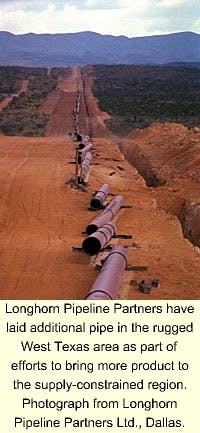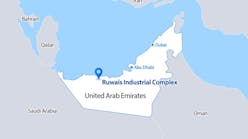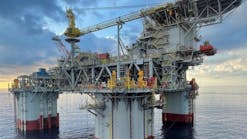Additional safety features and mitigation measures will push completion of Longhorn Partners Pipeline LP products pipeline back another 6 months and add millions to the final cost.
The features were ordered last month by the US Environmental Protection Agency. Begun in 1995 and estimated to cost nearly $400 million, the line will carry refined products from Houston to El Paso (Fig. 1).
The 700-mile pipeline includes a 450-mile section from Houston to Crane in the Permian Basin that was built in the 1950s to carry West Texas crude to Gulf Coast refineries. Longhorn Partners acquired that pipeline in 1995 with the aim of reversing its flow to carry gasoline and other refined products from Houston-area refineries to markets in West Texas, New Mexico, and Arizona.
That original pipeline crosses the environmentally sensitive Edwards Aquifer in central Texas, a unique groundwater system that includes one of the most prolific artesian aquifers on the globe. It is officially designated as the sole source of drinking water for some 1.5 million people, including the cities of San Antonio and Austin, the Texas capital.
EPA approval of the proposed safety and mitigation program came on instructions the White House Council on Environmental Quality in September after Longhorn Partners agreed to 40 steps to reduce ecological dangers along the pipeline route.
Protection, observation measures
EPA officials described the measures as "extraordinary" and added that none like them has been required on any pipeline in the country. They meet or exceed any future pipeline safety requirements under consideration in the US Congress.
The pipeline will be the first to ban products that contain methyl tertiary butyl ether (MTBE) or similar additives-tertiary amyl methyl ether, ethyl tertiary butyl ether, di-isopropyl ether-in greater than trace amounts, EPA officials said.
As part of the environmental agreement, Longhorn Partners will also replace with thicker-walled pipe 19 miles of 1950s-vintage pipe over a section of the Edwards Aquifer near Austin. The replacement pipe is to be buried at a depth to reduce the potential for third-party damage, with a concrete barrier installed over it as additional protection.
The partners also are required to design and develop a trench across that section of the aquifer's recharge and contributing zones to capture any accidental release. They also must install a system across the recharge and nearby contributing zones that is capable of detecting "even very small leaks" within 12-20 min of initial discharge.
Pipeline pump stations are to be inspected every 21/2 days in environmentally sensitive and highly populated areas. Remote cameras are to be installed to monitor all pump stations prior to start-up.
Longhorn Partners formed an accident response partnership with Boots & Coots International Well Control Inc., Houston, and will fund an office for Boots & Coots in Central Texas that, in addition to the emergency firm's existing oil field facilities on the Gulf Coast and in the Permian Basin, will ensure prompt reaction at any point along the pipeline.
Moreover, new valves are being installed on the pipeline in such sensitive areas as the Edwards Aquifer and river crossings that will let operators quickly shutdown the flow of products through the pipeline and safely drain the line if necessary. Some of the valves had already been installed, said the company in commenting on EPA's ruling.
Also, under the environmental agreement, Longhorn must perform semiannual pipe-to-soil potential surveys in sensitive areas along the pipeline-twice as often as currently required by US Department of Transportation (DOT) regulations, officials said.
The partnership also must do aerial and ground surveillance of the pipeline every day in the Edwards Aquifer area; every 21/2 days in other environmentally sensitive and highly populated areas; and weekly in all other regions.
All of those schedules also are more frequent than now required by law, officials said.
Pipeline marker signs in both English and Spanish must be posted at more frequent intervals along the pipeline route than now specified by industry standards, including at all aboveground facilities and on each side of public road, water, and railroad crossings.
In addition, Longhorn Pipeline is required to cease operation during "extreme flood conditions" at its Pedernales River crossing. Longhorn Partners must pay an outside contractor to test water quality at 12 locations near stream crossings and arrange alternate water supplies for municipalities and private water-well owners "that have sensitive groundwater resources" along the pipeline route.
The additional safety and mitigation measures will add "tens of millions" of dollars to the pipeline's total cost, partnership officials told OGJ Online.
What's been done
Workers weld up more line along Longhorn Pipeline's right-of-way, which runs through one of the most environmentally sensitive areas of Texas. Photograph from Longhorn Pipeline Partners Ltd., Dallas.
Longhorn Partners has already installed a new state-of-the-art system that will monitor pipeline operations every few seconds around the clock. It measures volumes entering and exiting the pipeline, along with suction and discharge pressures at pump stations to detect any leakage.
Some of the mitigation measures also will improve the safety of two other pipelines that share the corridor with Longhorn Pipeline along much of its route, officials said.
From 1995 through 1998, the partnership cleaned, tested, and upgraded the existing crude oil pipeline with new safety and environmental protections as part of its conversion. The line also was extended, including a 9-mile addition in the Houston area and a 250-mile stretch across West Texas to El Paso on the Mexican border.
A new spur was built from Crane to Odessa in the heart of the Permian Basin, Texas' main oil-producing area, where gasoline and other refined products typically cost 10-20¢/gal more than in those areas directly served by Gulf Coast refineries.
The proposed pipeline would provide a method for Gulf Coast refiners to move large quantities of products at lower costs to West Texas. Proponents claim the cheaper supply of cleaner-burning motor fuels could help reduce the air pollution that has become a sensitive international issue between the border cities of El Paso and Juarez, Mexico.
Interconnections with other pipelines in West Texas could also move refined products into New Mexico and Arizona. That would relieve pressures on the California market since that state now exports large quantities of gasoline and diesel fuel into Arizona, proponents said.
Legal troubles
But in 1998, several West Texas landowners filed a federal lawsuit against Longhorn Partners, the EPA, and DOT to halt the proposed pipeline because of its alleged threat to the Edwards Aquifer.
All but two of the landowners later withdrew from the suit, which was subsequently joined by the City of Austin, the Lower Colorado River Authority, the Barton Springs/Edwards Aquifer Conservation District, and others.
Media reports and statements by property owners who dropped out of the suit later indicated that the original lawsuit was funded by Navajo Refining Co., Artesia, NM, that sells gasoline and diesel into the West Texas, New Mexico, and Arizona markets.
Longhorn Partners subsequently sued Navajo in state court for illegal interference with existing and prospective contracts and for antitrust violations (OGJ, July 20, 1998, p. 36).
Meanwhile, the federal judge issued a temporary injunction against the pipe line.
In 1999, parties to that original suit agreed to a voluntary environmental assessment jointly directed by EPA and DOT.
As part of that study, an outside contractor analyzed 8,100 segments of the pipeline, checking for safety along its entire length.
A draft report of that assessment was released in October 1999 with a preliminary finding of no significant impact on the environment by the proposed pipeline.
If final judicial approval is granted by a federal judge, Longhorn Partners expects to open the pipeline by mid-2001.





